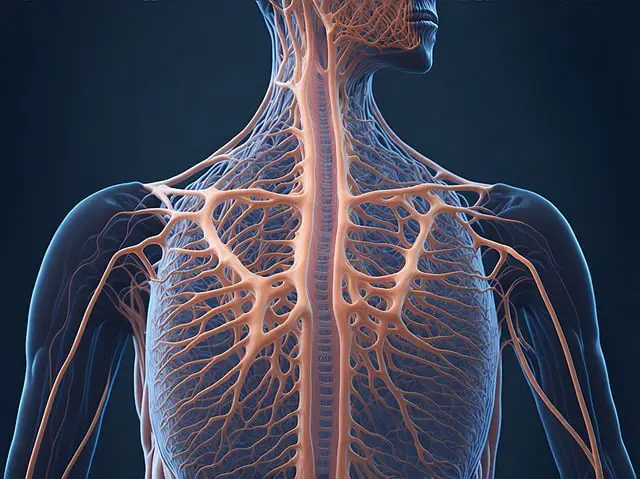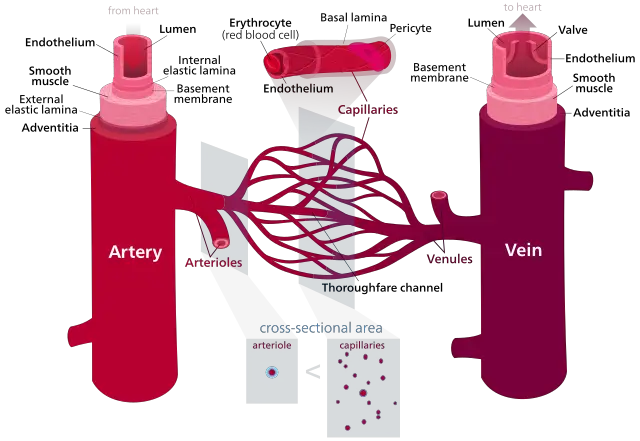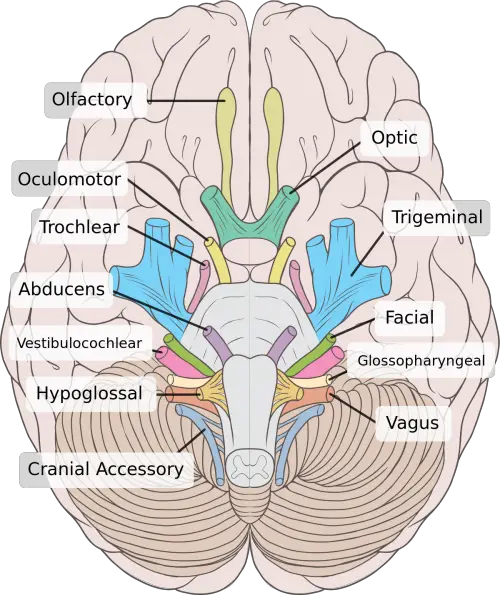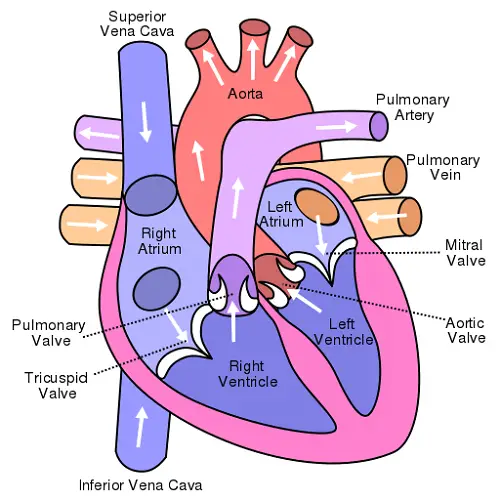
Nerves and veins are both vital components of the human body, but they serve different functions. However, there are some similarities between them:
- Structural Composition:
- Both nerves and veins are composed of multiple tissue layers. Nerves consist of neurons and supporting cells, while veins have three main layers: the tunica intima, tunica media, and tunica externa.
- Distribution in the Body:
- Nerves and veins are found throughout the body, forming extensive networks. Nerves are part of the nervous system, while veins are a component of the circulatory system.
- Network Formation:
- Both nerves and veins form intricate networks within tissues and organs. Nerves create neural networks to transmit signals, while veins form vascular networks to transport blood back to the heart.
- Vascular Support:
- Veins and nerves receive vascular support. Veins, being blood vessels, are part of the circulatory system that delivers nutrients and oxygen. Nerves also require a vascular supply for nourishment and support.
- Protection:
- Both nerves and veins are protected by connective tissues. Veins are surrounded by various layers, including the tunica externa, providing structural support. Nerves are enclosed in protective coverings such as the epineurium.
- Role in Homeostasis:
- Both contribute to the maintenance of homeostasis in the body. Veins help regulate blood pressure and ensure proper circulation. Nerves play a crucial role in transmitting signals for various physiological processes, contributing to overall homeostasis.
Despite these similarities, it’s important to note that nerves and veins have distinct functions and play different roles in the body. Nerves are responsible for transmitting electrical signals and information throughout the nervous system, while veins are involved in the return of deoxygenated blood to the heart in the circulatory system.
What are Nerves?
Nerves are a crucial part of the nervous system, which is responsible for transmitting signals, also known as nerve impulses or action potentials, throughout the body. The nervous system is divided into two main components: the central nervous system (CNS) and the peripheral nervous system (PNS). Nerves are a component of the PNS.
Here are the key features and components of nerves:
- Composition:
- Nerves are composed of specialized cells called neurons, which are the basic functional units of the nervous system. Neurons have a cell body, dendrites that receive signals, and an axon that transmits signals to other cells.
- Function:
- The primary function of nerves is to transmit electrical signals or nerve impulses. These signals carry information between different parts of the body, allowing for communication and coordination of various physiological functions.
- Types of Nerves:
- Nerves can be classified into different types based on their functions. Some nerves carry sensory information from the body to the brain (sensory or afferent nerves), while others transmit signals from the brain to muscles or glands (motor or efferent nerves). Mixed nerves carry both sensory and motor fibers.
- Peripheral Nervous System (PNS):
- Nerves are a major component of the peripheral nervous system. The PNS includes all nerves and ganglia (clusters of nerve cell bodies) outside the CNS. Peripheral nerves connect the CNS to various organs, muscles, and sensory receptors throughout the body.
- Connective Tissues:
- Nerves are surrounded by layers of connective tissues that provide protection and support. The epineurium is the outermost layer, followed by the perineurium, which surrounds bundles of nerve fibers, and the endoneurium, which surrounds individual nerve fibers.
- Transmission of Signals:
- Nerves transmit signals through a process involving the generation and propagation of action potentials. These electrical impulses travel along the axons of neurons and can cross synapses to communicate with other neurons or effector cells (muscles or glands).
- Role in Reflexes:
- Nerves are essential for reflex actions. Reflexes are rapid, automatic responses to stimuli that help protect the body and maintain physiological balance. Reflex arcs involve the transmission of signals through nerves without direct involvement of the brain.
In summary, nerves are essential components of the peripheral nervous system, facilitating communication and coordination between different parts of the body. They play a critical role in sensory perception, motor control, and overall physiological regulation.

What are Veins?
Veins are blood vessels that form a part of the circulatory system, responsible for transporting blood back to the heart. They are one of the three main types of blood vessels in the body, alongside arteries and capillaries. Veins play a crucial role in the circulation of blood throughout the body.
Here are key features and functions of veins:
- Blood Transport:
- Veins carry blood, primarily deoxygenated blood, from various tissues and organs back to the heart. This blood is then pumped to the lungs for oxygenation before being circulated to the rest of the body.
- Composition:
- Like arteries, veins are composed of three main layers: the tunica intima (innermost layer), tunica media (middle layer), and tunica externa (outermost layer). However, veins generally have thinner walls and larger lumens compared to arteries.
- Valves:
- Many veins, especially those in the extremities, have one-way valves that help prevent the backflow of blood. These valves assist in maintaining the direction of blood flow toward the heart.
- Low Pressure System:
- Veins operate at lower pressure compared to arteries. Since they are responsible for returning blood to the heart, they do not need the same level of pressure as arteries, which carry blood away from the heart.
- Return of Deoxygenated Blood:
- Veins play a critical role in returning deoxygenated blood, which has delivered oxygen to body tissues, back to the heart. This process is essential for the continuous circulation of blood and the efficient exchange of gases and nutrients.
- Systemic and Pulmonary Circulation:
- Veins are part of both systemic and pulmonary circulation. Systemic veins return deoxygenated blood from the body’s tissues to the right atrium of the heart, while pulmonary veins carry oxygenated blood from the lungs to the left atrium.
- Capacitance Vessels:
- Veins are often referred to as capacitance vessels because they can stretch and hold a significant amount of blood. This ability allows veins to act as reservoirs, helping to regulate blood volume and maintain blood pressure.
- Superficial and Deep Veins:
- Veins can be categorized as superficial or deep. Superficial veins are closer to the surface of the body, while deep veins are located deeper within the tissues. Superficial veins are often visible beneath the skin.
Understanding the functions of veins is crucial for comprehending the overall dynamics of the circulatory system and how blood is continuously circulated, delivering oxygen and nutrients to tissues while removing waste products.
What are the differences between Nerves and Veins?
Nerves and veins are distinct structures in the human body with different functions and compositions. Here are the key differences between nerves and veins:
- Function:
- Nerves: Nerves are part of the nervous system and are responsible for transmitting electrical signals (nerve impulses) throughout the body. They play a crucial role in sensory perception, motor control, and the coordination of various physiological functions.
- Veins: Veins are blood vessels that transport blood, primarily deoxygenated blood, from various tissues and organs back to the heart. They are a crucial component of the circulatory system.
- Composition:
- Nerves: Nerves are composed of specialized cells called neurons. Neurons have a cell body, dendrites that receive signals, and an axon that transmits signals to other cells.
- Veins: Veins are composed of three main layers: the tunica intima (innermost layer), tunica media (middle layer), and tunica externa (outermost layer). They also contain valves to prevent backflow of blood.
- Location and Distribution:
- Nerves: Nerves are distributed throughout the body, forming extensive networks in various tissues and organs. They are part of both the central nervous system (CNS) and the peripheral nervous system (PNS).
- Veins: Veins are found throughout the body, forming a network that returns blood to the heart. They can be superficial (closer to the surface of the body) or deep (located deeper within tissues).
- Role in Communication:
- Nerves: Nerves transmit signals, allowing communication between different parts of the body. They play a key role in conveying sensory information, motor commands, and coordinating reflexes.
- Veins: Veins do not have a communicative role. Their primary function is to transport blood and participate in the circulatory system, facilitating the return of deoxygenated blood to the heart.
- Nature of Signals:
- Nerves: Nerves transmit electrical signals or action potentials.
- Veins: Veins transport blood, and they do not transmit electrical signals.
- Protective Coverings:
- Nerves: Nerves are enclosed in protective coverings, including the epineurium, perineurium, and endoneurium.
- Veins: Veins are surrounded by connective tissues, but they lack the specialized protective coverings found in nerves.
- Involvement in Reflexes:
- Nerves: Nerves are essential for reflex actions, which are rapid and automatic responses to stimuli.
- Veins: Veins do not play a direct role in reflex actions.
Understanding these differences highlights the specialized functions of nerves and veins in the body and their contributions to the nervous and circulatory systems, respectively.
Table summarizing the similarities and differences between Nerves and Veins
Here’s a table summarizing the key similarities and differences between nerves and veins:
| Aspect | Nerves | Veins |
|---|---|---|
| Function | Transmit electrical signals (nerve impulses) for communication and coordination. | Transport blood, primarily deoxygenated, back to the heart as part of the circulatory system. |
| Composition | Composed of neurons with cell bodies, dendrites, and axons. | Composed of three layers: tunica intima, tunica media, and tunica externa, with valves to prevent backflow. |
| Location and Distribution | Distributed throughout the body, forming networks in various tissues and organs. | Found throughout the body, with superficial and deep veins returning blood to the heart. |
| Role in Communication | Transmit electrical signals, facilitating sensory perception, motor control, and coordination. | Do not have a communicative role; primary function is blood transport. |
| Nature of Signals | Transmit electrical signals or action potentials. | Transport blood and do not transmit electrical signals. |
| Protective Coverings | Enclosed in protective coverings (epineurium, perineurium, endoneurium). | Surrounded by connective tissues but lack specialized protective coverings. |
| Involvement in Reflexes | Essential for reflex actions, contributing to rapid and automatic responses. | Do not play a direct role in reflex actions. |
This table provides a concise overview of the main similarities and differences between nerves and veins, emphasizing their distinct roles in the nervous and circulatory systems, respectively.
Summary of Similarities Between Nerves and Veins
While nerves and veins serve different functions in the body, there are some general similarities between them:
- Tissue Composition:
- Both nerves and veins are composed of different types of tissues. Nerves consist of neurons, which have cell bodies, dendrites, and axons. Veins, on the other hand, have three main layers: tunica intima, tunica media, and tunica externa.
- Distribution in the Body:
- Both nerves and veins are distributed throughout the body, forming extensive networks. Nerves are found in tissues and organs, playing a role in communication and coordination. Veins create a network for the transport of blood, returning it to the heart.
- Connective Tissues:
- Both structures are surrounded by connective tissues that provide support and protection. Nerves have protective coverings such as the epineurium, perineurium, and endoneurium. Veins are surrounded by the tunica externa, providing structural support.
- Presence in Superficial and Deep Layers:
- Both nerves and veins can be found in both superficial and deep layers within the body. Superficial veins are closer to the body’s surface, while deep veins are located within tissues.
- Role in Overall Body Functionality:
- Nerves and veins both contribute to the overall functionality of the body. Nerves play a vital role in transmitting signals for sensory perception, motor control, and coordination. Veins are essential for the circulatory system, facilitating the return of deoxygenated blood to the heart.
While these similarities exist, it’s crucial to recognize that nerves and veins have distinct functions and play different roles in maintaining the body’s homeostasis and functionality.
Here are some frequently asked questions (FAQs) related to Nerves and Veins
Here are some frequently asked questions (FAQs) related to nerves and veins:
Nerves:
- What is the function of nerves in the body?
- Nerves transmit electrical signals or nerve impulses for communication and coordination. They play a crucial role in sensory perception, motor control, and various physiological functions.
- How are nerves structured?
- Nerves are composed of specialized cells called neurons, which have a cell body, dendrites for receiving signals, and an axon for transmitting signals.
- What is the role of nerves in reflex actions?
- Nerves are essential for reflex actions, which are rapid and automatic responses to stimuli. Reflex arcs involve the transmission of signals through nerves without direct involvement of the brain.
- How are nerves protected in the body?
- Nerves are enclosed in protective coverings, including the epineurium (outermost layer), perineurium (surrounding bundles of nerve fibers), and endoneurium (surrounding individual nerve fibers).
- Can nerves regenerate if damaged?
- Peripheral nerves have some capacity for regeneration, but the extent depends on various factors. Central nerves (within the spinal cord and brain) have limited regenerative capacity.
Veins:
- What is the main function of veins in the circulatory system?
- Veins transport blood, primarily deoxygenated blood, from various tissues and organs back to the heart. They are crucial for the return of blood to the heart.
- How are veins structured?
- Veins have three main layers: tunica intima, tunica media, and tunica externa. Many veins also contain one-way valves that prevent the backflow of blood.
- What is the difference between arteries and veins?
- Arteries carry blood away from the heart, usually oxygenated, while veins transport blood back to the heart, primarily deoxygenated.
- Why do veins appear blue under the skin?
- Veins appear blue or greenish through the skin due to the absorption and reflection of different wavelengths of light. The color is not directly related to the color of the blood.
- Can veins expand and contract like arteries?
- While veins can change diameter to some extent, they are not as elastic as arteries. Veins are often referred to as capacitance vessels because they can stretch and hold a significant amount of blood.
These FAQs provide a starting point for understanding the functions, structures, and roles of nerves and veins in the human body.
References:
A. I. Dakrory, T. G. Abdel-Kader, M. M. Hassan and G. J. Al-Malky (2022): Comparative anatomical studies on the cranial nerves of the fully formed embryos of the Nile tilapia Oreochromis niloticus (Ostiechthyes-Cichlidae). I. Nervus glossopharyngeus. Brazilian Journal of Biology, 2022, vol. 82, e245509 | https://doi.org/10.1590/1519-6984.245509
The Comparative Anatomy of the Nervous System of Vertebrates, Including Man JAMA. 1936;107(22):1833-1834. doi:10.1001/jama.1936.02770480065029
JD Nguyen (2021): Anatomy, Shoulder and Upper Limb, Veins – StatPearls Publishing LLC











Leave a Reply